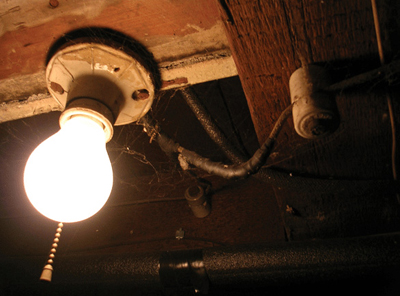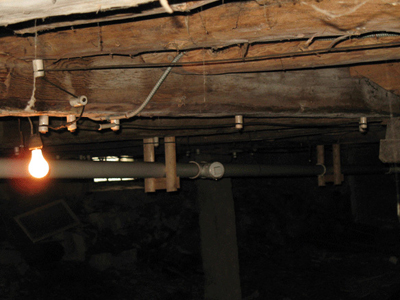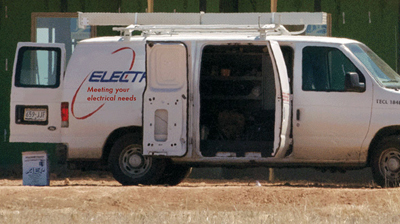 With the pressure of a depressed economy, knowledgeable contractors are seeing more and more work going to electricians who are working outside their areas of expertise. If you have found a good answer to this problem, we need to hear it.
With the pressure of a depressed economy, knowledgeable contractors are seeing more and more work going to electricians who are working outside their areas of expertise. If you have found a good answer to this problem, we need to hear it.
Two readers of my Residential Wiring column at Electrical Contractor contacted me within the last year, worried about incompetent, bottom-bidder work. Both talked about the special knowledge needed to deal with smaller and older wiring systems (and both granted permission to share their thoughts). I’ll start out with excerpts from Joel Emerson’s communication. He’s a Wisconsin contractor who’s been in the trade for 34 years.
Point One: Dried-up new-construction work sends crews into old systems they don’t understand.
[Assembly-line-type production wiremen, such as in large subdivision tract homes] are dealing with material they may never have seen before they or their bosses started scrabbling for any electrical work they could find. The alternative energy market is growing slowly, and it’s far from big enough to supplement or replace their piece of the greatly shrunk new-construction market. So they compete for jobs involving residential service and upgrades, systems they may not realize they don’t understand. Similarly, industrial/commercial electricians are suddenly confronted with old wiring such as two-wire NM.
Point two: Ignorant work is dangerous — for example . . .
 Now these people run into black iron [enameled conduit] and BX [Type AC cable]. People who’ve always had a ground wire to use, rather than relying on a raceway or sheath listed for grounding, neglect to tighten locknuts.
Now these people run into black iron [enameled conduit] and BX [Type AC cable]. People who’ve always had a ground wire to use, rather than relying on a raceway or sheath listed for grounding, neglect to tighten locknuts.
Rag wiring [rubber-and-cloth insulated conductors]? They neglect to tape conductors whose insulation is failing.
Corner-grounded three-phase? They assume it’s single-phase 240 because it only uses two-pole breakers, and they assume the ungrounded conductor of any circuit served by a single-pole breaker is at 120 volts to ground. They may never have encountered or even read about 240-volt, 3-phase Delta service with a grounded “B” phase. Yet my local utility, Wisconsin Electric, stopped providing service with a grounded “B” phase to customers such as woodworking shops quite recently. Many small commercial/industrial customers in my area rely on these services. They feed loads requiring 120 volts either by paying for a second service or by installing a customer transformer.
Point three: Old work is learnable, but many electricians don’t even keep up with code updates.
There are too many laid-off handymen, underemployed [industrial and commercial] pipe and wire jockeys and hard-up [production wiremen] trying to enter the residential repair and remodel markets. They simply never took the time or gained the experience needed to learn all the varieties of problems they can encounter from the many different types of residential construction used over the past 100 years. Also, they have not kept up with the municipal, state, NEC, or IBC codes pertaining to house wiring or specialized commercial wiring, codes which are always vastly changing. They apply their limited knowledge and they end up making life-threatening mistakes.
Point four: It’s up to us to make sure work is performed properly; customers don’t know enough.
 Homeowners don’t understand the dangers of hiring them. Residential remodeling and repair are the best markets open to us today. However, this work should be left to those who are adequately qualified and experienced.
Homeowners don’t understand the dangers of hiring them. Residential remodeling and repair are the best markets open to us today. However, this work should be left to those who are adequately qualified and experienced.
Joel’s personal answer to one aspect of the problem:
I’ve seen at least three houses, located in different communities, where someone had brought a handful of old 15- and 20-amp circuits into a big junction box, because they didn’t reach the new panel’s location. From the junction box, the worker had run 12-2 NM to the new panel. Fine, so far. However, because what he had brought to the panel was all 12 AWG, the [production wiremen] protected every one of the circuits at 20 amps. This is one of the reasons that, on any 50–60 year old branch-circuit wiring, I install only 15-amp circuit breakers, preferably with AFCI protection.
Editorial comment: Not every master or journeyman is suitable for supervising all types of job.
I can underscore Joel’s fourth point by noting that if you haven’t studied or worked with old wiring, you may not constitute a qualified person under the definition in NEC Article 100. But can AHJs monitor how well fitted a licensed electrician is to handle a particular job? Probably only by catching errors during the inspector’s [site inspection].
Tom Schulte is another reader with related issues. Here are excerpts from his email:
Point One: Tom believes that licensing exams should be tougher — not open-book.
 I have been a licensed electrician in California since 1982. Late in 2006, I moved to South Carolina with my family. After three-plus years of residence, I applied for and was given reciprocity as a fully licensed electrical contractor. This saved hundreds of dollars needed for the open-book exam, not to mention a lot of time driving. Yes — open book!
I have been a licensed electrician in California since 1982. Late in 2006, I moved to South Carolina with my family. After three-plus years of residence, I applied for and was given reciprocity as a fully licensed electrical contractor. This saved hundreds of dollars needed for the open-book exam, not to mention a lot of time driving. Yes — open book!
Speaking from the residential perspective, I have found the hard way that selling prevention is tough. . . . Joe Homeowner’s thinking seems to be that as long as nothing catches fire, everything is fine. Homeowners don’t know what they don’t know, but they do know that they are saving money in the short run by not having to hire qualified, actively licensed electricians with track records, who have invested a large portion of their life learning how to make things safe for the end user.
Point two: It’s hard for a contractor, who clearly has a vested interest in drumming up additional business, to convince laypersons to invest in electrical safety.
I still try to educate various customers that soon they will have a problem unless they take necessary measures — necessary from a professional’s point of view. Unfortunately, most clients mostly hear me saying, “I’m going to make some more money from this guy/company.”
Point three: Ignorant or greedy installers, whether licensed or not, often use the cheapest wiring available — and under-protect it!
 In this area of the country . . . people are content to use NM cable wherever they can. [Big box hardware stores] carry an ample supply at a price the electrical suppliers cannot touch. It is common to find (frequently under-protected) 14 gauge wiring installed in high- and medium-priced houses. The problems come in when it is tapped from 20-A circuits (usually by the handyman) . . . Incidentally and unfortunately, not every licensed electrician will follow code if the job is not inspected.
In this area of the country . . . people are content to use NM cable wherever they can. [Big box hardware stores] carry an ample supply at a price the electrical suppliers cannot touch. It is common to find (frequently under-protected) 14 gauge wiring installed in high- and medium-priced houses. The problems come in when it is tapped from 20-A circuits (usually by the handyman) . . . Incidentally and unfortunately, not every licensed electrician will follow code if the job is not inspected.
Point four: What’s important is not finding someone to blame, but getting everyone to do what’s right from the start. Tom is not hopeful.
As to where the blame lies, my answer is that it lies with everyone. Everyone encompasses the past and current homeowners, the home inspector (who cannot possibly check all issues), the city inspector/s — assuming a permit was pulled and signed off on. Lastly, let’s not forget the realtor whose bottom line depends on selling the house. . . .
It is always easiest after a problem to point the finger at the lowest man on the totem pole, or if you are the insurance company, the most easily intimidated contractor who has assets. The fact is the problem needs to be addressed at a much higher level, if there is a real interest in reducing incidents. I’m not advocating that we need more Big Brother. We just need everyone involved in the chain to act responsibly. Yeah, that will happen — when pigs fly.
Point five: Homeowners in his area may feel unable or unwilling to pay for professional-level help.
Tom added this, later:
A large majority of “transplants,” as they are called, have moved to the South expecting cheaper prices. They soon discover that they cannot find [worker] prices they want at the professional level.
David’s perspective: AHJs as well as homeowners bear some responsibility.
Moving on from Tom’s issues, I myself have run into problems specifically with our response to homeowners who’ve been misled.
One builder had told a customer that the various trades renovating her apartment were all covered under his license. Of course this inventive guy didn’t pull a permit. When I saw the dangerous wiring and learned what had happened, I asked the homeowner to report him. (By carrying a license, the builder made himself more vulnerable than other members of the gray economy.) The homeowner acknowledged that by reporting him, she might protect others from being hoodwinked. Nonetheless, she refused to contact the department of consumer and regulatory affairs; she just didn’t want the hassle.
What hassle? A few months earlier, I received a call from another homeowner in the same jurisdiction who had suffered from miswiring, this time performed by a carpenter. I told her that the work he had bollixed required a license and permit. She was shocked to learn this. She hastened on down to the department of consumer and regulatory affairs and reported what had happened. The person at the desk told her that she had a choice: either she reported the illegal work, in which case she would have to pay a $1000.00 fine for having authorized it, or she could pull a homeowner’s permit to cover the work herself.
What message did this convey? “Ignorance of the law is no excuse” does not justify penalizing the ignorant victim who is trying to do right and letting more-knowledgeable abusers go free. I wonder how your jurisdictions handle these cases. What kind of message does your own jurisdiction’s approach send? How well does that fit with the goals that we all want to achieve? It may not match them. In that case, is there any way you can influence the policy?
Joel, Tom, and I are not alone in feeling frustrated when we find dangerous work and see how the systems we have in place let bad wiring slip by. Maybe economic improvement will reduce some of the incompetent activity, as the daredevils tackling work they don’t understand move back into work they do know.
Meanwhile, what can we do about this situation?














Find Us on Socials